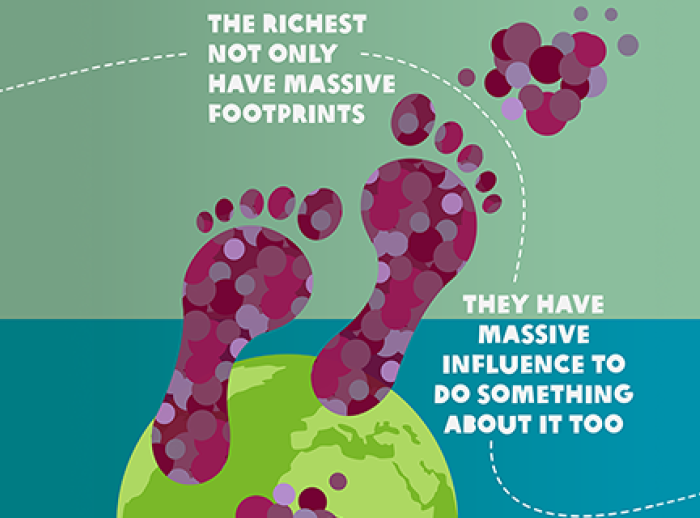- 3 min read
- Published: 2nd November 2021
Carbon emissions of globe’s richest 1% set to be 30 times the 1.5°C limit in 2030

The carbon footprints of the world’s richest 1 percent are set to be 30 times greater than the level compatible with the 1.5°C goal of the Paris Agreement in 2030, according to new research out today. It comes as delegates grapple with how to keep this goal alive at the COP26 meeting in Glasgow.
In 2015, governments agreed to the goal of limiting global heating to 1.5°C above pre-industrial levels, but current pledges to reduce emissions fall far short of what is needed. To stay within this limit, every person on the planet would need to emit an average of just 2.3 tonnes of CO2 per year by 2030 – this would be a reduction of roughly half the average footprint of every person on Earth today.
Today’s study, commissioned by Oxfam based on research carried out by the Institute for European Environmental Policy (IEEP) and the Stockholm Environment Institute (SEI), estimates how governments’ pledges will affect the carbon footprints of richer and poorer people around the world. It treats the global population and income groups as if they were a single country and finds that globally by 2030:
-
The poorest half of the global population will still emit far below the 1.5°C-aligned level in 2030.
-
The richest 1 percent and 10 percent of people are set to exceed this level by 30 times and 9 times, respectively.
-
Someone in the richest 1 percent – leading emitters, would need to reduce their emissions by around 97 percent compared with today to reach this level.
While research on carbon inequality in Ireland undertaken by Oxfam Ireland last year revealed that:
-
The average carbon footprint of the Irish population is currently nearly 4 times where it needs to be in 2030 to be 1.5°C-aligned
-
The top 1 percent and 10 per cent of the Irish population is currently almost 30 times and 10 times where it needs to be in 2030, respectively
-
The bottom 50 percent of the Irish population emits nearly half the carbons emissions of the average person in Ireland
This data related to Ireland need to be considered, as Ireland updates its plans to address climate change and seeks to fulfil its commitments to the Paris Agreement. Those most vulnerable to climate breakdown are the very same people that have contributed least to causing the problem. To achieve climate justice, those most responsible for causing climate change, both in Ireland and around the world, have the most responsibility for addressing this issue. To do this, Ireland must put tackling addressing carbon inequality at the heart of its climate action plans.
Speaking from COP26 in Glasgow, Simon Murtagh, Oxfam Ireland’s Senior Climate Policy Lead, said: “The emissions from a single billionaire flight would exceed the lifetime emissions of someone in the poorest billion people on Earth. A tiny elite appear to have a free pass to pollute. Their over-sized emissions are fuelling extreme weather around the world and jeopardising the international goal of limiting global heating. The emissions of the wealthiest 10 percent of the world alone could send us beyond the agreed limit in the next nine years, creating deadly storms, hunger and destitution.”
Oxfam said world leaders should focus on targeting deeper emissions cuts by 2030, in line with their fair share, and ensure that the richest people worldwide and within countries make the most radical cuts. The richest citizens have the potential to speed up this process dramatically, both by leading greener lifestyles, but also by directing their political influence and investments towards a low-carbon economy.
Specific recommendations for the Irish Government include:
- Ensuring that all climate actions are equality proofed and that mechanisms are put in place to offset any negative impacts of climate action on low-income groups
- Introducing focused policy measures targeting excessive and luxury emissions, for example progressive carbon pricing, targeted at luxury carbon goods and services (private jets, SUVs), to fund investment in energy efficiency measures in low-income households
- Designing a new decent job guarantees for those sectors of the economy that will be most impacted by the transition to a post-carbon future.
